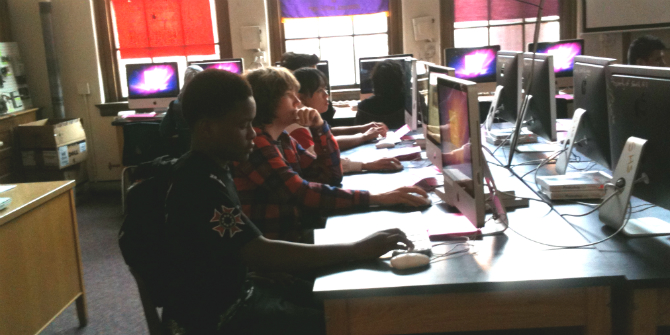Book Review: Distrusting educational technology – Critical questions for changing times
August 7, 2015
PROJECTS: Preparing for a Digital Future
TAGS: edtech
 Guest blogger Wendy M. Grossman reflects on Neil Selwyn’s recent book “Distrusting educational technology” and highlights its key arguments that counter the hype and optimism that typically surround educational technologies. She assesses Selwyn’s call for distrust of such technologies as fair, but finds that they still offer choices and opportunities. Wendy writes about the border wars between cyberspace and real life. She is the 2013 winner of the Enigma Award and she has released a number of books, articles, and music.
Guest blogger Wendy M. Grossman reflects on Neil Selwyn’s recent book “Distrusting educational technology” and highlights its key arguments that counter the hype and optimism that typically surround educational technologies. She assesses Selwyn’s call for distrust of such technologies as fair, but finds that they still offer choices and opportunities. Wendy writes about the border wars between cyberspace and real life. She is the 2013 winner of the Enigma Award and she has released a number of books, articles, and music.
The idea of replacing classrooms, teachers and books with more ‘modern’ technologies goes back at least to 1925, when Thomas Edison thought the film projector would replace books. Radio, TV, and most recently, computers, all play roles as educational tools. And ninety years after Edison, teachers and classrooms remain the dominant pedagogical model.
If the debate was an updated version of calculators versus slide rules, the conversation would be quite short. But the wide array of educational technologies provokes broad questions, some of which The Atlantic recently explored in a piece on “why technology alone won’t fix schools.” Should we ‘gamify’ learning so that it’s more appealing? Do students need to attend school, or can they learn just as well via social media?
In Distrusting educational technology, Neil Selwyn, Professor of Education at Australia’s Monash University, and editor of the journal Learning, Media and Technology, aims to counter the hype and optimism that typically surrounds educational technologies. After all, it’s now a global market Selwyn estimates at US$5 trillion annually. Far from being value-neutral, as technology generally is often painted, Selwyn contends that educational technologies typically display one of three embedded political ideologies: libertarian, neoliberal or new economy.
Selwyn begins by defining four categories of educational technology: virtual, games, open, and social. ‘Virtual’ includes simulations that teach specific skills, such as surgery or flying a plane, as well as online learning support and virtual classrooms. ‘Games’ includes both those specifically designed to teach traditional school subjects such as mathematics and those played for entertainment. While the idea that mathematics is valuable for life is generally accepted, the notion that gaming for entertainment imparts useful life skills is new. In 2006, for example, John Seely Brown and Douglas Thomas reported in Wired that employers viewed achieving ‘guildmaster’ in the game World of Warcraft as evidence of valuable team leadership skills; Brown and Thomas called it ‘learning to be’ rather than ‘learning about’.
Selwyn’s third category, ‘open’, covers open source software and public collaborative sites such as Wikipedia that offer open access for both readers and writers/editors.
Finally, ‘social’ refers to social media such as Facebook and Twitter, increasingly used by schools (and certainly students); he includes YouTube in this category. As Selwyn admits, there’s a great deal of overlap among these categories. For its editors, at least, Wikipedia is as much a social platform as YouTube, just as YouTube may host as much publicly accessible educational material as Coursera.
Selwyn analyses each category to show that rather than provide a radically new approach, each tends to reinforce existing power structures, narrowing, rather than expanding, what students learn. Virtual education, for example, tends to replicate the schoolroom and authoritative teacher.

Credit: Lynn Schofield Clark
Although the unique selling point of open source software is that anyone may modify and adapt it as needed, few have the skill or interest to do so. Games that offer points and leaderboards substitute fictional incentives for real ones. The vast majority of people using social media are primarily passive consumers.
At the same time, these technologies tend to turn education from persistent individual relationships between teachers and students into quantifiable market economies. Because the already advantaged tend to have better access to digital technologies, educational technologies exacerbate existing social inequality and unfairness. The elite, Selwyn says, would rather have a ‘digitally docile’ majority than foster the development of increasing numbers of disruptive individuals. He does not expect everyone to agree with him, but hopes for ‘informed controversy rather than uninformed consensus’.
There are some points Selwyn misses. Since the earliest 1980s social media such as bulletin board systems and the global discussion platform Usenet (which he does not mention), the vast majority of users of every service have been lurkers, consuming rather than contributing. But passive consumption is rarely consistently distributed, and a lurker in one space is a contributor in another: I am active on Twitter, post rarely on Facebook, and only watch on YouTube.
Similarly, while he is correct about both the demographics (largely male, often aggressively so) and elite nature of contributors to open source software, it’s wrong to ignore the fact that open source software offers possibilities that do not exist with its proprietary counterpart. Distrust it by all means, but at least it offers choices.
A key source of the difficulties with educational technology Selwyn highlights is that the inventors of these technologies are usually those who were too bright for ‘average’ learning situations. Many others who have benefited cannot be served in mainstream classrooms, such as the severely autistic New York teenager Daniel Bergmann, who has completed many courses via online learning. Selwyn focuses on the mainstream rather than such outliers.
Selwyn alludes to but does not directly address the vast issue of privacy invasion and endemic monitoring that these technologies enable. All of a student’s interactions with a computer can be recorded and mined later, a normalising of surveillance that children’s advocates such as Terri Dowty, director of the now-defunct Action for the Rights of Children, have warned about for years.
The book is aimed more at education policy-makers than at parents, though parents certainly play an important role in the kinds of choices they make in the interests of helping their children learn.
Selwyn concludes by arguing for greater engagement with teachers, students, parents and the many interested organisations, to oppose ‘ideological dominance’, advocating a greater role for the state in guiding the development of educational technology to limit the market’s influence.
He wants us to resist the rhetoric of inevitability and certainty that surrounds modern technological growth. Is the purpose of education to teach job skills or critical thinking? Do we want to teach individualism and self-determination, as Selwyn argues today’s technologies do, or collective civic responsibility? Selwyn is fighting an uphill battle against the appeal of the deceptively simple answers technology claims to offer.

